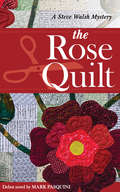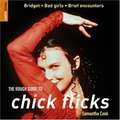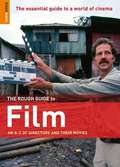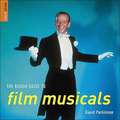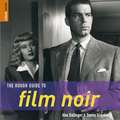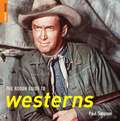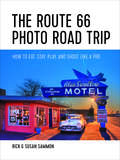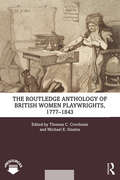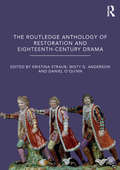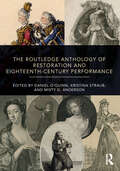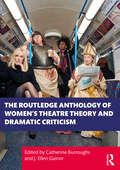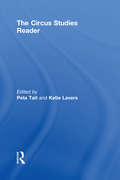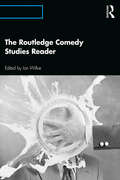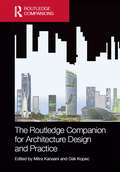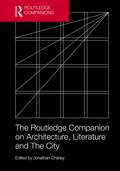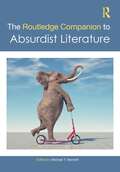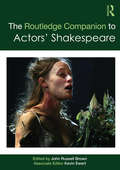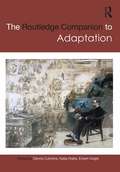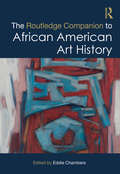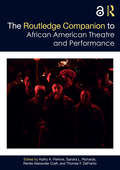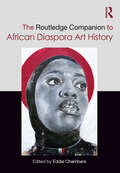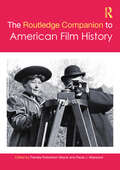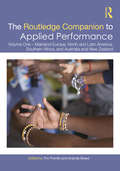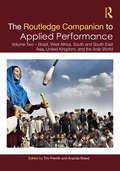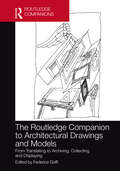- Table View
- List View
The Rose Quilt: A Steve Walsh Mystery
by Mark PasquiniIn the Roaring Twenties, a detective must sew up a case of quilting gone wrong—first in the cozy mystery series. It is the 1920s, in the world of quilting circles. Alice Chandler, a wealthy woman and prominent local quilter, is murdered with a pair of quilting shears during the preparations for a local flower show, leaving a dying clue on the lap quilt she and the executive committee are making as the first prize. Unfortunately, the clue could point to anyone on the committee or any of her three adopted children . . . Connecticut State Police lead investigator Steve Walsh is on the case, helped and hindered at every turn by the Alice&’s flapper daughter and by the scrappy reporter Julie Boroni. While trying to catch the killer, Steve&’s bachelor life may come to end—but with whom? A classic murder mystery with a quilty twist, this historical fiction novel is sure to grab every quilter&’s imagination and make them long for a bygone era.
The Rough Guide to Chick Flicks
by Samatha CookThis covers everything, from the history of cinema and the different films made around the world, to the stars, the directors, people behind the scenes, details on costume design and many film reviews.
The Rough Guide to Film
by Richard Armstrong Jessica Winter Tom Charity Lloyd HughesThe Rough Guide to Film arranges film reviews according to directors, profiling both the mavericks and the lesser-known auteurs in many different genres. Each film is placed in the context of the director's career, with extensive cross-referencing that enables film buffs to view the entire body of work by a particular individual. Broader issues are also discussed, such as film genres, movements and innovations. This latest entry to the Rough Guide series is edited by Armstrong, Charity, Hughes and Winter, who are all noted film critics and scholars. Annotation ©2008 Book News, Inc., Portland, OR (booknews.com)
The Rough Guide to Film Musicals
by David ParkinsonComplete with a list of the best soundtracks, websites and books for further reading, this Rough Guide takes a behind the scenes look at this magical movie genre.
The Rough Guide to Film Noir
by Alex Ballinger Danny GraydonFrom dimly lit streets and glamorous apartments to world-weary detectives and irresistible femmes fatales, The Rough Guide to Film Noir illuminates every corner of cinema's darkest and most compelling genre. From early masterpieces like Double Indemnity and Kiss Me Deadly through to neo-noir classics such as Chinatown and LA Confidential, this book highlights all the groundbreaking noir movies. There are profiles of legendary performers such as Humphrey Bogart and Barbara Stanwyck, great directors like Fritz Lang plus key cinematographers, composers and designers. Complete with website listings and books for further reading, this Rough Guide takes a fascinating look at the noir movies made in the Classical Hollywood era and beyond.
The Rough Guide to Westerns
by Paul SimpsonFrom the saloon to the cattle trail, gunslinging outlaws to ferocious Indians, The Rough Guide to Westerns is the ultimate companion to the genre that has, since the birth of cinema, fed our fascination with the Wild West. The origins: How the myth of the West was shaped as much by entertainers like Buffalo Bill and James Fenimore Cooper as by real-life figures like Wyatt Earp and Billy the Kid, The history: From the silent era, through 50s box-office domination, to spaghetti and 21st-century Westerns, The canon: 50 essential Westerns, including Stagecoach, Once Upon A Time In The West, High Noon and The Searchers, The icons: Profiles of legends such as John Wayne, John Ford, Sergio Leone, Clint Eastwood and Gary Cooper, And the rest: Westerns from around the world, archetypal characters, iconic locations, and the best books, magazines and websites.
The Route 66 Photo Road Trip: How To Eat, Stay, Play, And Shoot Like A Pro
by Rick Sammon Susan SammonThe essential guide to enjoying and photographing the Mother Road “Rick Sammon has a super power: he makes any photographic technique or concept simple to understand.” — PhotoFocus.com From legendary photographer Rick Sammon and his wife, Susan, The Route 66 Photo Road Trip is the perfect companion to enjoying and photographing everything that the country’s most famous highway has to offer, whether you’re hauling professional gear or just your phone! One of the earliest cross-country routes for the first American motor tourists, Route 66 still teems with nostalgic attractions and natural wonder. The Sammons guide you from Amarillo to Las Vegas, focusing on the thriving and historical southwest segment of the highway featuring classic venues like the 66 Diner and the Hotel Andaluz. This guide includes recommendations for dining and lodging, lists of attractions, hour- by- hour road itineraries, and essential tips for capturing memorable photographs by day or night, stopped or in a moving car, with a DSLR or an iPhone.
The Routledge Anthology of British Women Playwrights, 1777-1843
by Thomas C. Crochunis Michael E. SinatraThe Routledge Anthology of British Women Playwrights, 1777-1843 brings together ten eclectic plays by female dramatists and writers, to stimulate a rich discussion of women, writing, and theatre history. Ranging through tragedy, comedy, musical theatre and mixed-genre texts, this volume celebrates the breadth and experimental spirit of women's eighteenth- and nineteenth-century dramatic writing. Each play is accompanied by an introductory essay that addresses its sociopolitical and theatrical contexts, and outlines its performance and reception history. The selections included here invite teachers and their students to study particular works by authors of note, but also to consider the differences between works written for page and stage. While many of the plays are recognizable as published dramas, they have been placed alongside textual artifacts that suggest plays or theatrical events of which no definitive record exists, as well as supplementary materials that invite teachers to engage their students in exploring women's dramatic writing in this era. Organized in chronological order, The Routledge Anthology of British Women Playwrights, 1777-1843 traces a history of women's writing across genres and styles, offering an invaluable resource to students and teachers alike.
The Routledge Anthology of Restoration and Eighteenth-Century Drama
by Kristina Straub, Misty Anderson, and Daniel O’QuinnThe Routledge Anthology of Restoration and Eighteenth-Century Drama brings together the work of key playwrights from 1660 to 1800, divided into three main sections: Restoring the Theatre: 1660–1700 Managing Entertainment: 1700–1760 Entertainment in an Age of Revolutions: 1760–1800 Each of the 20 plays featured is accompanied by an extraordinary wealth of print and online supplementary materials, including primary critical sources, commentaries, illustrations, and reviews of productions. Taking in the spectrum of this period’s dramatic landscape—from Restoration tragedy and comedies of manners to ballad opera and gothic spectacle—The Routledge Anthology of Restoration and Eighteenth-Century Drama is an essential resource for students and teachers alike.
The Routledge Anthology of Restoration and Eighteenth-Century Performance
by Kristina Straub Misty G. Anderson Daniel O’QuinnThe Routledge Anthology of Restoration and Eighteenth-Century Performance brings together a selection of particularly memorable performances, beginning with Nell Gwyn in a 1668 staging of Secret Love, and moving chronologically towards the final performance of John Philip Kemble's controversial adaptation of Thomas Otway's Venice Presever'd in October 1795. This volume contains a wealth of contextual materials, including contemporary reviews, portraits, advertisements, and cast lists. By privileging event over publication, this collection aims to encourage an understanding of performance that emphasizes the immediacy - and changeability - of the theatrical repertoire during the long eighteenth century. Offering an invaluable insight into the performance culture of the time, The Routledge Anthology of Restoration and Eighteenth-Century Performance is a unique, much-needed resource for students of theatre.
The Routledge Anthology of Women's Theatre Theory and Dramatic Criticism
by J. Ellen Gainor Catherine BurroughsThe Routledge Anthology of Women's Theatre Theory and Dramatic Criticism is the first wide-ranging anthology of theatre theory and dramatic criticism by women writers. Reproducing key primary documents contextualized by short essays, the collection situates women’s writing within, and also reframes the field’s male-defined and male-dominated traditions. Its collection of documents demonstrates women’s consistent and wide-ranging engagement with writing about theatre and performance and offers a more expansive understanding of the forms and locations of such theoretical and critical writing, dealing with materials that often lie outside established production and publication venues. This alternative tradition of theatre writing that emerges allows contemporary readers to form new ways of conceptualizing the field, bringing to the fore a long-neglected, vibrant, intelligent, deeply informed, and expanded canon that generates a new era of scholarship, learning, and artistry. The Routledge Anthology of Women's Theatrical Theory and Dramatic Criticism is an important intervention into the fields of Theatre and Performance Studies, Literary Studies, and Cultural History, while adding new dimensions to Feminist, Gender and Sexuality Studies.
The Routledge Circus Studies Reader
by Peta Tait and Katie LaversThe Routledge Circus Studies Reader offers an absorbing critical introduction to this diverse and emerging field. It brings together the work of over 30 scholars in this discipline, including Janet Davis, Helen Stoddart and Peta Tait, to highlight and address the field’s key historical, critical and theoretical issues. It is organised into three accessible sections, Perspectives, Precedents and Presents, which approach historical aspects, current issues, and the future of circus performance. The chapters, grouped together into 13 theme-based sub-sections, provide a clear entry point into the field and emphasise the diversity of approaches available to students and scholars of circus studies. Classic accounts of performance, including pieces by Philippe Petit and Friedrich Nietzsche, are included alongside more recent scholarship in the field. Edited by two scholars whose work is strongly connected to the dynamic world of performance, The Routledge Circus Studies Reader is an essential teaching and study resource for the emerging discipline of circus studies. It also provides a stimulating introduction to the field for lovers of circus.
The Routledge Comedy Studies Reader
by Ian WilkieThe Routledge Comedy Studies Reader is a selection of the most outstanding critical analysis featured in the journal Comedy Studies in the decade since its inception in 2010. The Reader illustrates the multiple perspectives that are available when analysing comedy. Wilkie’s selections present an array of critical approaches from interdisciplinary scholars, all of whom evaluate comedy from different angles and adopt a range of writing styles to explore the phenomenon. Divided into eight unique parts, the Reader offers both breadth and depth with its wide range of interdisciplinary articles and international perspectives. Of interest to students, scholars, and lovers of comedy alike, The Routledge Comedy Studies Reader offers a contemporary sample of general analyses of comedy as a mode, form, and genre.
The Routledge Companion for Architecture Design and Practice: Established and Emerging Trends
by Dak Kopec Mitra KanaaniThe Routledge Companion for Architecture Design and Practice provides an overview of established and emerging trends in architecture practice. Contributions of the latest research from international experts examine external forces applied to the practice and discipline of architecture. Each chapter contains up-to-date and relevant information about select aspects of architecture, and the changes this information will have on the future of the profession. The Companion contains thirty-five chapters, divided into seven parts: Theoretical Stances, Technology, Sustainability, Behavorism, Urbanism, Professional Practice and Society. Topics include: Evidence-Based Design, Performativity, Designing for Net Zero Energy, The Substance of Light in Design, Social Equity and Ethics for Sustainable Architecture, Universal Design, Design Psychology, Architecture, Branding and the Politics of Identity, The Role of BIM in Green Architecture, Public Health and the Design Process, Affordable Housing, Disaster Preparation and Mitigation, Diversity and many more. Each chapter follows the running theme of examining external forces applied to the practice and discipline of architecture in order to uncover the evolving theoretical tenets of what constitutes today’s architectural profession, and the tools that will be required of the future architect. This book considers architecture’s interdisciplinary nature, and addresses its current and evolving perspectives related to social, economic, environmental, technological, and globalization trends. These challenges are central to the future direction of architecture and as such this Companion will serve as an invaluable reference for undergraduate and postgraduate students, existing practitioners and future architects.
The Routledge Companion on Architecture, Literature and The City
by Jonathan CharleyThis Companion breaks new ground in our knowledge and understanding of the diverse relationships between literature, architecture, and the city, which together form a field of interdisciplinary research that is one of the most innovative and exciting to have emerged in recent years. Bringing together a wide variety of contributors, not only writers, architectural and literary scholars, and social scientists, but graphic novelists and artists, the book offers contemporary essays on everything from science fiction and the crime novel, to poetry, comics and oral history. It is structured into two sections: History, Narrative and Genre, and Strategy, Language and Form. Including over ninety illustrations, the book is a must read for academics and students.
The Routledge Companion to Absurdist Literature (Routledge Literature Companions)
by Michael Y. BennettThe Routledge Companion to Absurdist Literature is the first authoritative and definitive edited collection on absurdist literature. As a field-defining volume, the editor and the contributors are world leaders in this ever-exciting genre that includes some of the most important and influential writers of the twentieth century, including Samuel Beckett, Harold Pinter, Edward Albee, Eugene Ionesco, Jean Genet, and Albert Camus. Ever puzzling and always refusing to be pinned down, this book does not attempt to define absurdist literature, but attempts to examine its major and minor players. As such, the field is indirectly defined by examining its constituent writers. Not only investigating the so-called “Theatre of the Absurd,” this volume wades deeply into absurdist fiction and absurdist poetry, expanding much of our previous sense of what constitutes absurdist literature. Furthermore, long overdue, approximately one-third of the book is devoted to marginalized writers: black, Latin/x, female, LGBTQ+, and non-Western voices.
The Routledge Companion to Actors' Shakespeare (Routledge Companions)
by John Russell BrownThe Routledge Companion to Actors’ Shakespeare is a window onto how today’s actors contribute to the continuing life and relevance of Shakespeare’s plays. The process of acting is notoriously hard to document, but this volume reaches behind famous performances to examine the actors’ craft, their development and how they engage with playtexts. Each chapter relies upon privilieged access to its subject to offer an unparalleled insight into contemporary practice. This volume explores the techniques, interpretive approaches and performance styles of the following actors: Simon Russell Beale, Sinead Cusack, Judi Dench, Kate Duchene, Colm Feore, Mariah Gale, John Harrell, Greg Hicks, Rory Kinnear, Kevin Kline, Adrian Lester, Marcelo Magni, Ian McKellen, Patrice Naiambana, Vanessa Redgrave, Piotr Semak, Anthony Sher, Jonathan Slinger, Kate Valk, Harriet Walter This twin volume to The Routledge Companion to Directors’ Shakespeare is an essential work for both actors and students of Shakespeare.
The Routledge Companion to Adaptation (Routledge Companions)
by Dennis Cutchins Katja Krebs Eckart VoigtsThe Routledge Companion to Adaptation offers a broad range of scholarship from this growing, interdisciplinary field. With a basis in source-oriented studies, such as novel-to-stage and stage-to-film adaptations, this volume also seeks to highlight the new and innovative aspects of adaptation studies, ranging from theatre and dance to radio, television and new media. It is divided into five sections: Mapping, which presents a variety of perspectives on the scope and development of adaptation studies; Historiography, which investigates the ways in which adaptation engages with – and disrupts – history; Identity, which considers texts and practices in adaptation as sites of multiple and fluid identity formations; Reception, which examines the role played by an audience, considering the unpredictable relationships between adaptations and those who experience them; Technology, which focuses on the effects of ongoing technological advances and shifts on specific adaptations, and on the wider field of adaptation. An emphasis on adaptation-as-practice establishes methods of investigation that move beyond a purely comparative case study model. The Routledge Companion to Adaptation celebrates the complexity and diversity of adaptation studies, mapping the field across genres and disciplines.
The Routledge Companion to African American Art History (Routledge Art History and Visual Studies Companions)
by Eddie ChambersThis Companion authoritatively points to the main areas of enquiry within the subject of African American art history. The first section examines how African American art has been constructed over the course of a century of published scholarship. The second section studies how African American art is and has been taught and researched in academia. The third part focuses on how African American art has been reflected in art galleries and museums. The final section opens up understandings of what we mean when we speak of African American art. This book will be of interest to graduate students, researchers, and professors and may be used in American art, African American art, visual culture, and culture classes.
The Routledge Companion to African American Theatre and Performance (Routledge Companions)
by Kathy A. Perkins Sandra L. Richards Renée Alexander Craft Thomas F. DeFrantzThe Routledge Companion to African American Theatre and Performance is an outstanding collection of specially written essays that charts the emergence, development, and diversity of African American Theatre and Performance—from the nineteenth-century African Grove Theatre to Afrofuturism. Alongside chapters from scholars are contributions from theatre makers, including producers, theatre managers, choreographers, directors, designers, and critics. This ambitious Companion includes: A "Timeline of African American theatre and performance." Part I "Seeing ourselves onstage" explores the important experience of Black theatrical self-representation. Analyses of diverse topics including historical dramas, Broadway musicals, and experimental theatre allow readers to discover expansive articulations of Blackness. Part II "Institution building" highlights institutions that have nurtured Black people both on stage and behind the scenes. Topics include Historically Black Colleges and Universities (HBCUs), festivals, and black actor training. Part III "Theatre and social change" surveys key moments when Black people harnessed the power of theatre to affirm community realities and posit new representations for themselves and the nation as a whole. Topics include Du Bois and African Muslims, women of the Black Arts Movement, Afro-Latinx theatre, youth theatre, and operatic sustenance for an Afro future. Part IV "Expanding the traditional stage" examines Black performance traditions that privilege Black worldviews, sense-making, rituals, and innovation in everyday life. This section explores performances that prefer the space of the kitchen, classroom, club, or field. This book engages a wide audience of scholars, students, and theatre practitioners with its unprecedented breadth. More than anything, these invaluable insights not only offer a window onto the processes of producing work, but also the labour and economic issues that have shaped and enabled African American theatre.
The Routledge Companion to African Diaspora Art History (Routledge Art History and Visual Studies Companions)
by Eddie ChambersThis is an authoritative companion that is global in scope, recognizing the presence of African Diaspora artists across the world. It is a bold and broad reframing of this neglected branch of art history, challenging dominant presumptions about the field.Diaspora pertains to the global scattering or dispersal of, in this instance, African peoples, as well as their patterns of movement from the mid twentieth century onwards. Chapters in this book emphasize the importance of cross-fertilization, interconnectedness, and intersectionality in the framing of African Diaspora art history. The book stresses the complexities of artists born within, or living and working within, the African continent, alongside the complexities of Africa-born artists who have migrated to other parts of the world. The group of international contributors emphasizes and accentuates the interplay between, for example, Caribbean art and African Diaspora art, or Latin American art and African Diaspora art, or Black British art and African Diaspora art.The book will be of interest to scholars and students working in art history, the various branches of African studies, African American studies, African Diaspora studies, Caribbean studies, and Latin American studies.
The Routledge Companion to American Film History (Routledge Media and Cultural Studies Companions)
by Paula J. MassoodPresenting new and diverse scholarship, this collection brings together original essays that explore American film history from a fresh perspective.Comprising an introduction and 34 chapters written by leading scholars from around the globe, and edited by Pamela Robertson Wojcik and Paula J. Massood, this collection offers discussions of the American film industry from previously unexplored vantage points. Rather than follow a chronological format, as with most film histories, this Companion offers a multiplicity of approaches to historiography and is arranged according to often underdeveloped or overlooked areas in American film, including topics such as alternate archives, hidden labor, histories of style, racialized technologies, cinema’s material cultures, spectators and fans, transnational film production, intermedial histories, history in and about films, and the historical afterlives of cinema.An exciting collection for serious film studies students and scholars interested in new perspectives and fresh approaches to thinking about and doing American film history.
The Routledge Companion to Applied Performance: Volume One – Mainland Europe, North and Latin America, Southern Africa, and Australia and New Zealand (Routledge Companions)
by Tim Prentki and Ananda BreedThe Routledge Companion to Applied Performance provides an in-depth, far-reaching and provocative consideration of how scholars and artists negotiate the theoretical, historical and practical politics of applied performance, both in the academy and beyond. These volumes offer insights from within and beyond the sphere of English-speaking scholarship, curated by regional experts in applied performance. The reader will gain an understanding of some of the dominant preoccupations of performance in specified regions, enhanced by contextual framing. From the dis(h)arming of the human body through dance in Colombia to clowning with dementia in Australia, via challenges to violent nationalism in the Balkans, transgender performance in Pakistan and resistance rap in Kashmir, the essays, interviews and scripts are eloquent testimony to the courage and hope of people who believe in the power of art to renew the human spirit. Students, academics, practitioners, policy-makers, cultural anthropologists and activists will benefit from the opportunities to forge new networks and develop in-depth comparative research offered by this bold, global project.
The Routledge Companion to Applied Performance: Volume Two – Brazil, West Africa, South and South East Asia, United Kingdom, and the Arab World (Routledge Companions)
by Tim Prentki and Ananda BreedThe Routledge Companion to Applied Performance provides an in-depth, far-reaching and provocative consideration of how scholars and artists negotiate the theoretical, historical and practical politics of applied performance, both in the academy and beyond. These volumes offer insights from within and beyond the sphere of English-speaking scholarship, curated by regional experts in applied performance. The reader will gain an understanding of some of the dominant preoccupations of performance in specified regions, enhanced by contextual framing. From the dis(h)arming of the human body through dance in Colombia to clowning with dementia in Australia, via challenges to violent nationalism in the Balkans, transgender performance in Pakistan and resistance rap in Kashmir, the essays, interviews and scripts are eloquent testimony to the courage and hope of people who believe in the power of art to renew the human spirit. Students, academics, practitioners, policy-makers, cultural anthropologists and activists will benefit from the opportunities to forge new networks and develop in-depth comparative research offered by this bold, global project.
The Routledge Companion to Architectural Drawings and Models: From Translating to Archiving, Collecting and Displaying (Routledge International Handbooks)
by Federica GoffiArchitectural drawings and models are instruments of imagination, communication, and historical continuity. The role of drawings and models, and their ownership, placement, and authorship in a ubiquitous digital age deserve careful consideration. Expanding on the well-established discussion of the translation from drawings to buildings, this book fills a lacuna in current scholarship, questioning the significance of the lives of drawings and models after construction. Including emerging, well-known, and world-renowned scholars in the fields of architectural history and theory and curatorial practices, the thirty-five contributions define recent research in four key areas: drawing sites/sites of knowledge construction: drawing, office, construction site; the afterlife of drawings and models: archiving, collecting, displaying, and exhibiting; tools of making: architectural representations and their apparatus over time; and the ethical responsibilities of collecting and archiving: authorship, ownership, copyrights, and rights to copy. The research covers a wide range of geographies and delves into the practices of such architects as Sir John Soane, Superstudio, Eugène-Emmanuel Viollet-le-Duc, Frank Lloyd Wright, Wajiro Kon, Germán Samper Gnecco, A+PS, Mies van der Rohe, and Renzo Piano.
